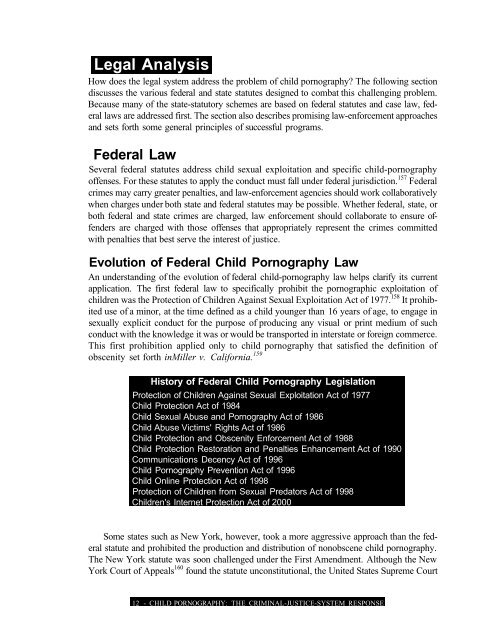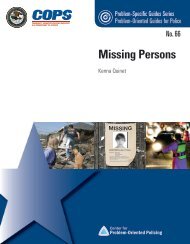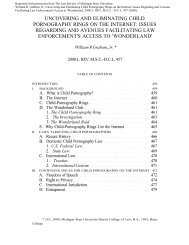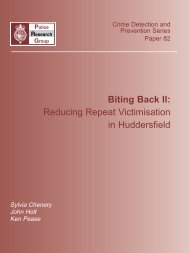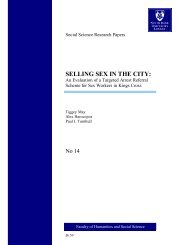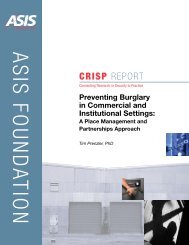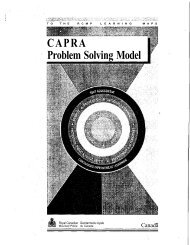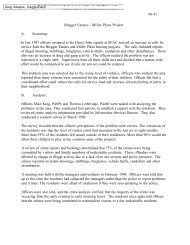Child Pornography: - Center for Problem-Oriented Policing
Child Pornography: - Center for Problem-Oriented Policing
Child Pornography: - Center for Problem-Oriented Policing
Create successful ePaper yourself
Turn your PDF publications into a flip-book with our unique Google optimized e-Paper software.
Legal Analysis<br />
How does the legal system address the problem of child pornography? The following section<br />
discusses the various federal and state statutes designed to combat this challenging problem.<br />
Because many of the state-statutory schemes are based on federal statutes and case law, federal<br />
laws are addressed first. The section also describes promising law-en<strong>for</strong>cement approaches<br />
and sets <strong>for</strong>th some general principles of successful programs.<br />
Federal Law<br />
Several federal statutes address child sexual exploitation and specific child-pornography<br />
offenses. For these statutes to apply the conduct must fall under federal jurisdiction. 157 Federal<br />
crimes may carry greater penalties, and law-en<strong>for</strong>cement agencies should work collaboratively<br />
when charges under both state and federal statutes may be possible. Whether federal, state, or<br />
both federal and state crimes are charged, law en<strong>for</strong>cement should collaborate to ensure offenders<br />
are charged with those offenses that appropriately represent the crimes committed<br />
with penalties that best serve the interest of justice.<br />
Evolution of Federal <strong>Child</strong> <strong>Pornography</strong> Law<br />
An understanding of the evolution of federal child-pornography law helps clarify its current<br />
application. The first federal law to specifically prohibit the pornographic exploitation of<br />
children was the Protection of <strong>Child</strong>ren Against Sexual Exploitation Act of 1977. 158 It prohibited<br />
use of a minor, at the time defined as a child younger than 16 years of age, to engage in<br />
sexually explicit conduct <strong>for</strong> the purpose of producing any visual or print medium of such<br />
conduct with the knowledge it was or would be transported in interstate or <strong>for</strong>eign commerce.<br />
This first prohibition applied only to child pornography that satisfied the definition of<br />
obscenity set <strong>for</strong>th inMiller v. Cali<strong>for</strong>nia. 159<br />
History of Federal <strong>Child</strong> <strong>Pornography</strong> Legislation<br />
Protection of <strong>Child</strong>ren Against Sexual Exploitation Act of 1977<br />
<strong>Child</strong> Protection Act of 1984<br />
<strong>Child</strong> Sexual Abuse and <strong>Pornography</strong> Act of 1986<br />
<strong>Child</strong> Abuse Victims' Rights Act of 1986<br />
<strong>Child</strong> Protection and Obscenity En<strong>for</strong>cement Act of 1988<br />
<strong>Child</strong> Protection Restoration and Penalties Enhancement Act of 1990<br />
Communications Decency Act of 1996<br />
<strong>Child</strong> <strong>Pornography</strong> Prevention Act of 1996<br />
<strong>Child</strong> Online Protection Act of 1998<br />
Protection of <strong>Child</strong>ren from Sexual Predators Act of 1998<br />
<strong>Child</strong>ren's Internet Protection Act of 2000<br />
Some states such as New York, however, took a more aggressive approach than the federal<br />
statute and prohibited the production and distribution of nonobscene child pornography.<br />
The New York statute was soon challenged under the First Amendment. Although the New<br />
York Court of Appeals 160 found the statute unconstitutional, the United States Supreme Court<br />
12 - CHILD PORNOGRAPHY: THE CRIMINAL-JUSTICE-SYSTEM RESPONSE


